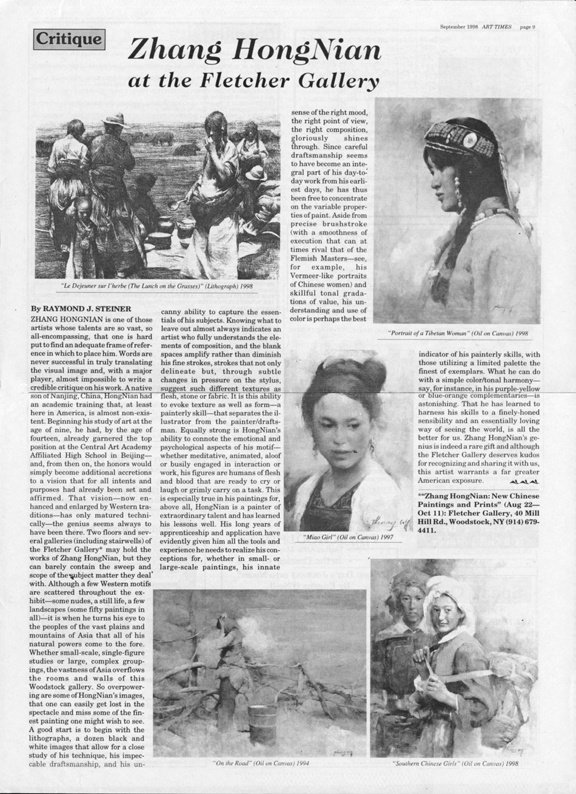Art Critique: HongNian Zhang at the Fletcher Gallery
By Raymond J. Steiner
ART TIMES September 1998
ZHANG HONGNIAN is one of those artists whose talents are so vast, so all-encompassing, that one is hard put to find an adequate frame of reference in which to place him. Words are never successful in truly translating the visual image and, with a major player, almost impossible to write a credible critique on his work. A native son of Nanjing, China, HongNian had an academic training that, at least here in America, is almost non-existent. Beginning his study of art at the age of nine, he had, by the age of fourteen, already garnered the top position at the Central Art Academy Affiliated High School in Beijing—and, from then on, the honors would simply become additional accretions to a vision that for all intents and purposes had already been set and affirmed. That vision—now enhanced and enlarged by Western traditions—has only matured technically—the genius seems always to have been there. Two floors and several galleries (including stairwells) of the Fletcher Gallery* may hold the works of Zhang HongNian, but they can barely contain the sweep and scope of the subject matter they deal with. Although a few Western motifs are scattered throughout the exhibit—some nudes, a still life, a few landscapes (some fifty paintings in all)—it is when he turns his eye to the peoples of the vast plains and mountains of Asia that all of his natural powers come to the fore. Whether small-scale, single-figure studies or large, complex groupings, the vastness of Asia overflows the rooms and walls of this Woodstock gallery. So overpowering are some of HongNian's images, that one can easily get lost in the spectacle and miss some of the finest painting one might wish to see. A good start is to begin with the lithographs, a dozen black and white images that allow for a close study of his technique, his impeccable draftsmanship, and his uncanny ability to capture the essentials of his subjects. Knowing what to leave out almost always indicates an artist who fully understands the elements of composition, and the blank spaces amplify rather than diminish his fine strokes, strokes that not only delineate but, through subtle changes in pressure on the stylus, suggest such different textures as flesh, stone or fabric. It is this ability to evoke texture as well as form—a painterly skill—that separates the illustrator from the painter/draftsman. Equally strong is HongNian's ability to connote the emotional and psychological aspects of his motif—whether meditative, animated, aloof or busily engaged in interaction or work, his figures are humans of flesh and blood that are ready to cry or laugh or grimly carry on a task. This is especially true in his paintings for, above all, HongNian is a painter of extraordinary talent and has learned his lessons well. His long years of apprenticeship and application have evidently given him all the tools and experience he needs to realize his conceptions for, whether in small- or large-scale paintings, his innate sense of the right mood, the right point of view, the right composition, gloriously shines through. Since careful draftsmanship seems to have become an integral part of his day-to-day work from his earliest days, he has thus been free to concentrate on the variable properties of paint. Aside from precise brushstroke (with a smoothness of execution that can at times rival that of the Flemish Masters—see, for example, his Vermeer-like portraits of Chinese women) and skillful tonal gradations of value, his understanding and use of color is perhaps the best indicator of his painterly skills, with those utilizing a limited palette the finest of exemplars. What he can do with a simple color/tonal harmony—say, for instance, in his purple-yellow or blue-orange complementaries—is astonishing. That he has learned to harness his skills to a finely-honed sensibility and an essentially loving way of seeing the world, is all the better for us. Zhang HongNian's genius is indeed a rare gift and although the Fletcher Gallery deserves kudos for recognizing and sharing it with us, this artist warrants a far greater American exposure.
*"Zhang HongNian: New Chinese Paintings and Prints" (Aug 22—Oct 11): Fletcher Gallery, 40 Mill Hill Rd., Woodstock, NY (914) 679-4411.

